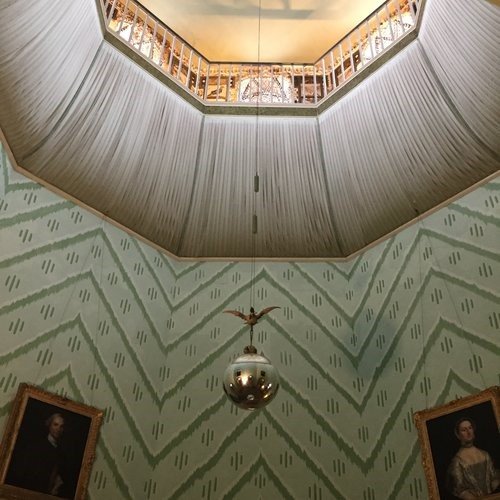A la Ronde, South Devon
A sixteen-sided house, sat overlooking the Exe estuary in south Devon, designed and built by two unmarried 18th century women sounds like the beginning of a possible historic, fictional novel by Zadie Smith. It is in fact the true story of Jane and Mary Parminter who in 1796 following a ten-year Grand Tour of Europe embarked upon the challenge of building their own exquisitely designed house with estuarine views in the south west of England.
The house elevated above wildflower meadow pasture and with estuary views holds a commanding position. Built during Napoleon’s advancement through Europe, completed the same year of his battle at Caldiero, the prospect of invasion was real. The Battle of Fishguard in 1797 was a French invasion landing in Wales. Due to this threat, the ladies planned in tunnels below the house in case there was an imminent need to escape. The estuary position today, a welcome retreat and beautiful, but on the date of its inception, a riskier location.
Jane and Mary Parminter were two unmarried, well-educated, wealthy, young ladies. They were cousins who, with the option of marriage to a likely chosen suitor chose a very different and unconventional path for women of their time.
Perhaps they would have been better suited to our current social times than the late 18th century. This all makes A la Ronde that bit more exciting and adventurous. Adventurous in spirit, the ladies tour of Europe led them to create a house imbued with a sense of novelty.
The novelty of what travelling brings and the learning and ingesting of new designs, aesthetics guided their ideas. Based supposedly on the octagonal chapel of San Vitale in Ravenna, the sixteen sides, octagonal hallway and diamond windows fitted onto every corner are totally unique, locally and nationally.
The length and the breadth of where they travelled to and what they saw is mirrored in the amalgamation of styles and designs within the house. Small cupboards slotted in between rooms housing crockery and more unsightly objects are attractive and ingenious uses of space. The diamond windows use the Georgian sash technology but are altered. The sixteen-sided house allowed the ladies the ability to follow the sun at all times of the day leading to their final and most famous element of the house, the Shell Gallery.
The shell gallery on the upper walkway is an 8-sided shell encrusted grotto, designed and crafted by the cousins using shells they collected on their travels and others combed from the beaches of the Exe estuary below the house.
There is an air of the Bloomsbury set’s Charleston farmhouse to A la Ronde. Years before the likes of Virginia Woolf and Vanessa Bell were adorning the walls, doors, pottery and really anything they could cover with paintings and frescoes, Jane and Mary Parminter were encrusting A la Ronde’s walls and cornices with feathers, shells and different decorative painting techniques. Ingenious shutters for the diamond windows seem to be taken straight out of a Southern Italian villa with linen and netting to keep out the sun’s rays and keep a coolness to the rooms as the sun travelled around the property.
Beautifully crafted pietradura tables, clearly taken straight from their time in Florence on their Grand Tour sit alongside the feather fireplace surround. Shells sit within cabinets, perhaps too large or rejected from the grotto but stunning in their assembly. The entire house should be valued for showing how ingenuity, time and not taking design too seriously can create although small, unique masterpieces.
A la Ronde is injected with a sense of adventure and creativity. These were two women who eschewed convention and with it, embraced their freedom, chose instead to further their love of craft and design. In doing so they created a house that is almost unmatched in the country. Not set within a real sense of local vernacular, nor distinctly of the Georgian era, the house has a whole set of rules and aesthetic of its own.
Rivalled only in terms of curiosities and idiosyncrasies, is perhaps the Sir John Soanes Museum on Lincoln Inn Fields. The degree of eccentricity of rooms filled with shells, busts, antiquities, ‘nick-nacks’ is makes both properties wealthy treasure troves. What makes A la Ronde that little bit more unusual however is the basic matter of sex. One property is owned by a typical 18th century gentleman architect. The other owned by two unmarried wealthy ladies eschewing convention. Sir John was expected to travel to the continent and learn and bring back ideas and objets from his travels. Ladies were not.
Jane Parminter was the daughter of a wealthy Devon merchant who upon her father’s death, inherited a substantial fortune. Her wealth allowed the ladies to create the property at A la Ronde. Written into her will was the decree that the house should never be owned by a male heir and should always be passed down to unmarried female relatives. This held true for much of the life of A la Ronde. It has had one male owner who, although Jane may not have approved, made some needed restoration works and assisted in keeping the property together until the National Trust finally took control of the house in 1991. Having survived many years of possible redevelopment threats, with the roof being currently restored the house is set to live on for many years for women and men alike to enjoy the ideals and peculiarities of these two progressive and impressive women.




